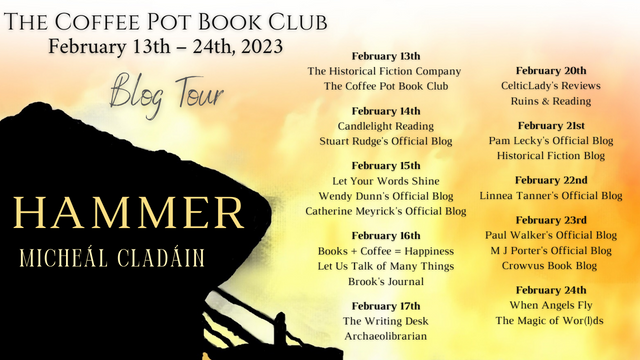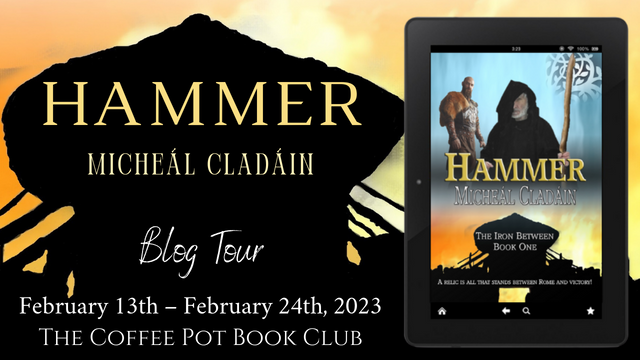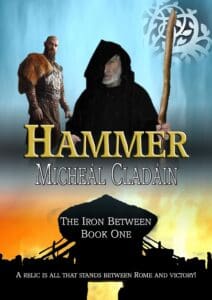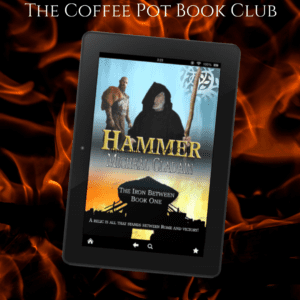
21 Feb Hammer Micheál Cladáin #Hammer #BlogTour #TheCoffeePotBookClub #HistoricalFiction @cladain_m @cathiedunn
FEATURED AUTHOR: MICHEÁL CLADÁIN
I am pleased to host Micheál Cladáin again as the featured author in The Coffee Pot Book Club Blog Tour being held between February 13th — February 24th, 2023. He is the author of the Historical Fiction novel, Hammer (The Iron Between Book One), released by PerchedCrowPress on 31 January 2023 (375 pages)
Below are highlights of Hammer, Micheál Cladáin’s author bio, and a post that I asked him to write about how the Romans viewed the Druids and their role in the Boudiccan uprising.

To follow the blog tour, CLICK Tour Schedule Page
HIGHLIGHTS: HAMMER

HAMMER
(The Iron Between Book One)
by Micheál Cladáin
(Blurb)
Genonn’s tired and dreams of a remote roundhouse in the Cuala Mountains.
However, sudden rebellion in Roman Britain destroys that dream because the Elder Council task him with delivering Lorg Mór, the hammer of the Gods, to the tribes across the straits of Pwll Ceris. Despite being torn between a waning sense of duty and his desire to become a hermit, Genonn finally agrees to help.
When his daughter follows him into danger, it tests his resolve. He wants to do everything he can to see her back to Druid Island and her mother. This new test of will means he is once again conflicted between duty and desire. Ultimately, his sense of duty wins; is it the right decision? Has he done the right thing by relegating his daughter’s safety below his commitment to the clans?
Buy Links:
Hammer is available to read on #KindleUnlimited.
Universal Link Amazon UK Amazon US Amazon CA Amazon AU
AUTHOR BIO: MICHEÁL CLADÁIN

Micheál has been an author for many years. He studied Classics and developed a love of Greek and Roman culture through those studies. In particular, he loved their mythologies. As well as a classical education, bedtime stories consisted of tales read from a great tome of Greek Mythology, and Micheál was destined to become a storyteller from those times.
Social Media Links:
Website Twitter Facebook Instagram Amazon Author Page Goodreads
How did the Romans View the Druids? What was their role in the Boudiccan uprising?

The primary Classical source for what we know about the druids is Julius Caesar. Other Romans, such as Tacitus and Pliny the Elder, touched on them briefly. Pliny described them as sadistic cannibals. Apart from the Fourteenth Legion crossing the Menai Straits and encountering druidic sorcerers, Tacitus does not have much to say. There are other sources, such as Strabo. Still, the entry on druids in the Encyclopaedia Britannica cites only Caesar, which speaks volumes. Regarding the Boudiccan uprising, our sources are Tacitus and Cassius Dio. Tacitus only mentions druids in the battle cited above, and Dio does not mention them.
Classical literature references the druids as early as the fourth century BCE. However, the first detailed account can be found in Caesar’s Comentarii De Bello Gallico, transliterated as The Gallic War. Many think his primary source on the druids to have been Posidonius of Rhodes, whose work is lost.
Scholars believe much of what Caesar wrote was propaganda and should be taken lightly. What he wrote about druids is nonetheless intriguing and the basis for the belief structure of neo-druidism.
Caesar tells us that the druids were one of two privileged classes, with equites (cavalry class, often translated as nobles or knights). He claimed that the rest of Celtic society comprised little more than enslaved people. This claim is obviously propaganda because we know the Celtic culture was complex and had many strata.
Note: Some believe the Celts were not a single race but disparate tribes who spoke a similar language, worshipped similar gods and followed similar cultural traits. The long-held belief that the Celts populated Europe through migration has been poo pood by modern archaeologists. For me, speaking a similar language, worshipping similar gods and following similar cultural traits defines them as a single race, but what do I know?
Caesar tells us that druids were a powerful political force, lawgivers, educators, doctors and scientists. Apart from questionable references to human sacrifice, he was highly impressed with the druidic class. All of what he wrote is in doubt, but the human sacrifice aspects have been somewhat born out by archaeological finds. However, classicists would say his writing about slavery and sacrifice was designed to sway the plebians to his cause. Roman commoners were much more forgiving of an invasion when they thought the conquered were barbarians.
In summary, during the Boudiccan rebellion, Caesar dictated how the Romans viewed druids and Caesar considered them both barbaric and scholarly.
As I wrote earlier, there is no evidence that the druids played a part in the rebellion of 60/61 CE. Tacitus did reference meeting druids during the invasion of Anglesey:
“…while between the ranks dashed women, in black attire like the Furies, with hair dishevelled, waving brands. All around, the Druids, lifting up their hands to heaven, and pouring forth dreadful imprecations, scared our soldiers by the unfamiliar sight, so that, as if their limbs were paralysed, they stood motionless, and exposed to wounds.”— The Annals of Imperial Rome by Cornelius Tacitus
He also wrote of how they used human sacrifice as a divination method. However, there is no other reference to them concerning the uprising.
Caesar tells us they were a major political power. By his definition, druids were involved in every aspect of their culture. As such, we can assume that they did play some part, whether it was divining possible outcomes or advising Boudica and clan chieftains. Dio tells us that Boudica performed her own divination. However, Dio’s account is highly suspect because he wrote over a hundred years after the uprising and contradicted much of Tacitus’s account.
Suetonius was on the cusp of conquering Anglesey when the rebellion broke out. The Celtic army had been destroyed opposing the Fourteenth Legion at the Menai Straits. The aim of the invasion was to eradicate the druids. So, what if the druids asked Boudica for help? What if the uprising was meant to divert the Roman soldiers away from Anglesey, thereby saving the druids?
The supposition is not implausible.
I can ignore the brutal treatment of Boudica and her daughters and say she did rebel because the druids demanded aid. I can also overlook the enslavement of her people at the hands of the Roman veterans occupying Camulodunum. In fact, for the sake of a good story, I can say that the druids demanded help, and Boudica was powerless to resist. They were, after all, a mighty organisation.
I think what I cannot really ignore is there were tribes much closer to Mona, such as the Ordovices. Aid from the Ordovices would have been much quicker. To my mind, the uprising probably had a different cause. I provide such a cause in my book, Hammer.

Instagram Handle: @thecoffeepotbookclub


Cathie Dunn
Posted at 05:45h, 22 FebruaryThanks so much for hosting Micheál Cladáin today. Such a fascinating post! xx
Linnea Tanner
Posted at 14:43h, 22 FebruaryIt was my pleasure to host the blog tour for Micheál Cladáin and spotlight his book, “Hammer.” This is definitely a period of history that I’m interested in.
Jan Sikes
Posted at 09:07h, 22 FebruaryThanks for sharing, Linnea! Best wishes to this author.
Linnea Tanner
Posted at 14:45h, 22 FebruaryThanks, Jan, for visiting and commenting on the blog tour for Micheál Cladáin. It is a period of ancient history in which I am most interested.
Luciana
Posted at 20:13h, 24 FebruaryBest wishes to Micheal on the release of his book. This is one I’ll be adding to my TBR list.